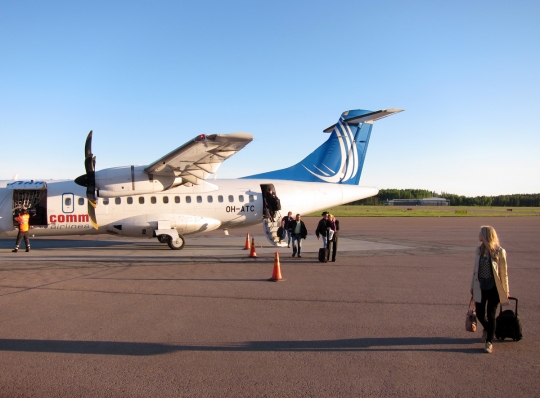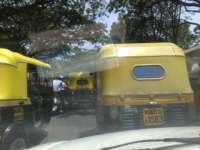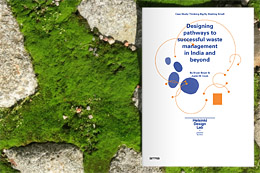All posts tagged Travels
It feels a bit like an air traffic control tower in our corner of Sitra-house these days. Between various physical comings and goings, we've also been in the thick of routing projects to and fro.
A big item for us was getting the first 100% text draft of the HDL Studio publication out the door. It was a bit later than we had hoped, so it's nice to have relief from the pressure of being behind schedule. Now that we're receiving feedback from a couple people who have been enlisted to be critical readers it's starting to feel more real. Soon TwoPoints will be doing layouts and then it's truly off. Throttle up.
Marco has been spending his time between Low2No and exploratory meetings for a new (and yet to be named) project. Early feedback is positive but we're still awaiting clearance for take off.
Meanwhile we've been continuing our in-house collaborations as well. In the past month we have really begun to dig into what the Synergize Finland studios will look like. Stuff like securing the studio leads, nailing down key bits of the schedule, and also taking the time to revisit some of the core principles and renew our shared commitment to them. Boarding completed. Requesting clearance to push back from the gate.
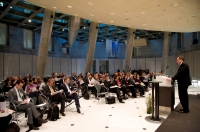
Opening of the SEE conference. Photo by Michael De Lausnay.
On Tuesday I was in Brussels to share Sitra's work with the guests of the SEE Project at their Policy, Innovation, and Design conference. I left the event feeling optimistic that the economic advantages of design+business, the so-called creative economy or ceative industries, is broadly appreciated. Design was also being used in multiple presentations as a way to bring the needs of users back into the center of decision making, particularly in the public sector.
It was nice to see the launch fo the Service Design Toolkit, for instance, because it gives tools to people who might already have the desire to work in a more empathetic way but are struggling to find a structured way to do so.

Outside the Flemish Parliament, venue of the SEE Project Final Conference: Policy, Innovation & Design
The mixed content of the event brought to the fore a point which seems unclear at times, particularly when "design" gets introduced to policy contexts. Does "design policy" focus on increasing the demand for design services in a "policy for (to support) design" sort of way? Or, on the other hand, does "design policy" refer to the use of design methods to deliver new or improved services, systems, or strategies?
The latter we think of as "policy by design" and that's squarely where we put our focus at Sitra through initiatives such as HDL. Both 'policy for design' and 'policy by design' have important roles to play, but being specific about which one is on the table at any given moment helps an audience to evaluate the value proposition of design. Thanks to Mark Vanderbeeken of Experientia for putting together a well-rounded lineup that succinctly crystalized these thoughts. Cleared for landing.
March is a good name for this month. That's what it feels like: a march. Summer is already just around the corner but there's a lot to be done between now and then. These past two weeks have mostly been about sharing.
Sharing with other teams at Sitra, sharing with the world via writing, and sharing with similar organizations who are developing new ways of working on comlex problems.
Marco and I continue to work with the Synergize Finland team as they will be using the Studio model this May. I gave them a brain dump on what a Challenge Briefing is, what role it plays in the studio, and how you structure a similar document. They're off and running on briefings for their studios and it will be cool to see the concept reflected back to us through their experience with it. Marco has been recruiting designers to play the role of studio lead.
During the past two weeks we've also submitted three article for publication on three continents. Two of those discuss the Studio model in greater detail, and the third looks at strategic design vis-a-vis the practice of architecture. We'll post links here when they are available—I believe the first will be the forthcoming issue of Volume Magazine on Ageing.
It feels great to have these deadlines behind us, and I wish I could say that the typing hands can rest now, but no! We soldier on with another big deadline for a draft due in the middle of March. This one is a self-imposed deadline to more thoroughly document the Studio model and our three studios last summer.
On the topic of studios, we caught this interview with John Seely Brown on the radio in Australia (mp3 link):
"In a world of constant change, [design is] the ability to imagine, the ability to take close assessments of where you are versus where you want to be, and figure out how to move from here to there. Design was a nice thing to have in the last few hundred years in a world of stability, but really the form of productive inquiry underlying design is now critical in a world of constant change.
Basically we're living in a world now where our skills have about a 5 year half life. when I started out doing stuff it was a 30 year half-life, so today we have to be at any age able to pick up brand new skills... The studio is one of the most concrete ways of working with the real, working with the concrete, letting the imagination fly, and then collectively with folks around you and mentors actually produce new knowledge."
We were out and about too. I gave a talk to Aalto University's Creative Sustainability course. Marco was in London to participate in the Ecobuild conference and share some of our experiences with Low2No. Afterwards he and I spent a morning catching up up with Nick Mabey at the HQ of E3G. They've just published Degrees of Risk which I haven't had time to read, but knowing Nick and his team it's should be thorough and insightful.
Degrees of Risk is the output of a multi-year process working with climate scientists and security experts to flesh out a framework for moving to a risk management approach to climate change, in contrast to the singular focus on migitiation. Doing so implicates a much wider array of decision-makers, from security to infrastructure, each with established ways to plan for future risk. The framework is an intensely clever way for hacking the climate debate to put it into terms that a larger group of people—everyone—gets: risk.
And now for an abrupt transition: from climate risk to sea ice. Under an unusually bright Sunday sky, I went for a walk on the sea ice last weekend to do a bit of research on Helsinki food culture.
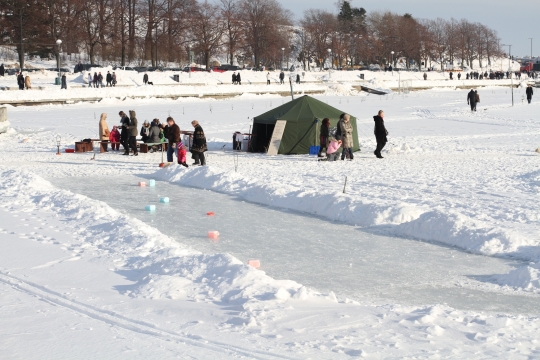
Temporary cafe set up on the ice... and curling sheet!
One of the delightful things about northern cities is the degree to which their geography changes during winter. Helsinki comes alive with recreational opportunities all across the frozen sea. Suddenly the isolated boat gas station becomes a winter cafe, with a new arrival path across the iced-over harbor. Remote coffee shops have new streams of guests who come to roast sausages on outdoor fire pits. Or have a curling match. This won't last for too much longer, given the warm weather we've been having, so I'll have to wait for next year to corral my colleagues into starting the Sitra Curling team.
Week 102 closes with a steady hum—and the clickety clack of more writing.
We're back from a week (#96) in Umeå, Sweden, home to the Umeå Institute of Design, and location of a courageous experiment in Prototyping the Future. Anna Valtonen, HDL Global 2010 participant and Rector of the school, decided to shut the place down for a week to pause and consider what the future of the design school may be. All students, staff, and even Anna herself put aside their course work to participate in special workshops taught by guest faculty. Marco, Justin, and myself brought the HDL Studio model to Umeå as an example of how designers might begin to play more strategic roles, especially in service to government.

Västerbotten is about the same size as Denmark but has only 1/16th the population.
To demonstrate this concept we teamed up with the county government of Västerbotten, the second largest county in Sweden and administrative region that includes the city of Umeå. Governor Chris Heister and Deputy Governor Birgitta Heijer issued a challenge: How can we make Västerbotten more attractive so that it attracts new residents and retains existing ones?
We asked the students to develop ways to rethink traditionally difficult aspects like the far northern location of Västerbotten as assets that could be utilized to develop a new vision for the county. Governor Heister described the unofficial slogan of the county as "In Västerbotten we have it all" which the studio flipped around to be "In Västerbotten you can have it all!" This highlights the county as a place of opportunity that benefits from diverse natural environments, geographies, urban densities, and lifestyles, where it's easy and comparatively cheap to take root.
The Governor issued the challenge, Sitra brought the HDL Studio model and played the role of facilitator, and UID students did the hard work. It was a hectic week, but a good one. We certainly learned a lot about what makes a studio tick and this is invaluable knowledge as we continue to hone the HDL Studio model.
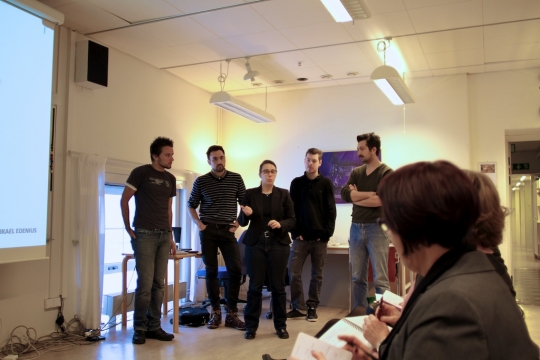
A snapshot from the final presentation
The students had a tall order ahead of them. With only five days to deliver they had to dive into new territories such as economics, public policy, and demographics; make sense of this tangled mess of perspectives; and propose a framework for developing a course of action for the county.
The presentation went well and sparked a lively discussion with the Governor and her guests. While the students are gathering up their presentation material I'll leave you with a cliff hanger, but as soon as the files materialize we'll prepare a dossier of the week. In the meantime, there are a pile of pictures up on Flickr.

The studio with Governor Heister and her guests
Week 95 was spent in London catching up with some other HDL Global 2010 participants in between meetings related to other Sitra business. It was especially great to catch up with Indy Johar of Research 00 Architecture as well as our friends at the Young Foundation.
Helsinki is under a heavy blanket of snow which has added a lovely bit of chaos to the streets. We're happy to accept the occasionally frightening skid-stop of a lumbering bus if the weather also brings with it amplified levels of daylight reflecting off the ground cover.
Last week Marco was in Brussels sharing HDL's work at the Design and Learning conference. I was away in Madrid doing the same with a group of innovation researchers sponsored by the Spanish National Research Council. The participants were a mix of academic and professionals which resulted in some productive friction as we adjusted to the language and concerns of our peers. I was particularly interested in Steve Flowers' work on defining different categories of user-led innovation. So often this term is treated as a homogenous lump of stuff, but Flowers breaks it down into five different levels of involvement that scale up in their innovation potential.
- Users provide feedback
- Users produce content for existing products
- Novel use of existing products
- Modification of existing products
- Creation of novel products
As he pointed out, not all user innovation is bound for the market. Sometimes (a lot of the time?) innovation, user-led or not, produces weird results. Such as a disused MiG mounted on a train used to clear snow off of train tracks.

Image borrowed from this collection of truck-mounted jet engines.
Drew Hemment shared his work on the FutureEverything festival which he sees as a vehicle for social innovation. The broad range of activities they're conducting is too much to go into here but it includes bubble races (PDF) used to measure urban heat island affects. Drew gave us a peek at an almanac of sorts which FutureEverything is now working on to share their methods with others looking to do something similar. It's encouraging to see such an open sharing of experience. We try to do the same thing with our How-Tos.
Meanwhile, Justin was in Germany with part of the Low2No team. He's been keeping weeknotes over at the Low2No site and I highly recommend reading them for the full scoop on how that project is coming along.
I'll close this update with a hearty congratulations to the SIX Social Innovation Exchange for their successful bid to create and EC-sponsored Social Innovation Initiative for Europe. HDL is happy to be part of the advisory board for this project and we look forward to being part of it.
That restfulness I wrote about last week? Yeah, that's gone. Week 083 started with an adventure. We climbed to the tip top of our building to get a good view of Jätkäsaari to take some photographs for Low2No.
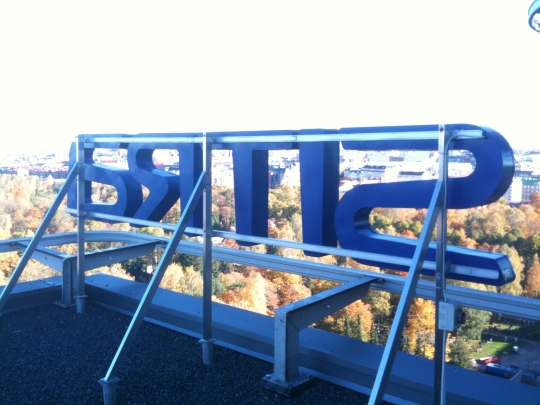
The "17th floor" (we only have 16 floors in our building)
Marcus Foth from the Queensland University of Technology was in town for a conference and dropped by to chat about urban informatics. They're working on some interesting applications of ubicomp relating to sustainability issues such as food and energy.
Marco is in Belfast sharing Sitra's work with a university there and savoring the last days of his holiday. Meanwhile, Justin is holding down the fort in our Boston office and I hopped over to Copenhagen for a day to catch up with INDEX and MindLab.
Liza (HDL Global 2010) and Niels at INDEX were gracious enough to host me for a morning of case study research. We're looking for another round of case study candidates. If you have any suggestions, please drop us a line! Through years of offering the design award, as well as student design challenges, INDEX has a wealth of knowledge about design projects around the world.
I also stopped by COBE, an architecture office that increasingly finds themselves working at the intersection of traditional architecture and strategy. Their Taastrup Theatre renovation/expansion project is nice example. Asked to renovate a concrete box of a theatre, the team engaged the local public through co-creation workshops to develop a shared vision. This led to an expanded brief and a new budget that enabled a stunning piece of architecture.
Next up was Mind Lab, where Christian (HDL Global 2010) shared his wealth of knowledge working as a design-oriented organization embedded within government. Spanning three ministries, Mind Lab is a really unique organization that combines anthropology, policy, and design knowledge to improve government services. Christian's new book Leading Public Sector Innovation: Co-Creating for a Better Society might be of interest to readers of this site. One of the simple pleasures of life is a meeting with no agenda, and that's what Christian and I had: a free-ranging discussion that covering many topics. As we think about the future of HDL and the role of design at Sitra, these kind of chats are very important.
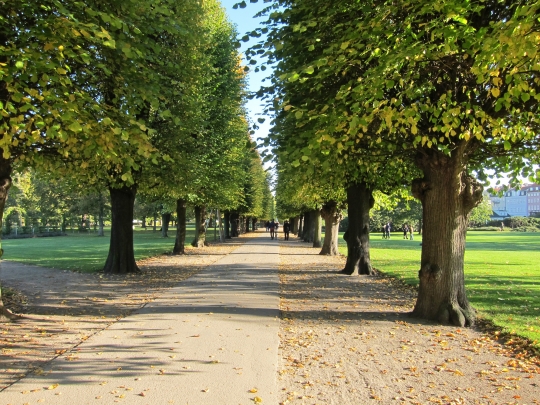
A walk through Copenhagen's Rosenborg castle gardens
It has been a great week for reflection. This morning we had a visit from Geoff Mulgan of the Young Foundation whose SIX Spring School we enjoyed exactly 20 weeks ago. Like Mind Lab, The Young Foundation are among some of the most interesting do-ers we know so it was a great coincidence that Geoff was in town and had time to stop by. He and his team are doing some work to clarify the various roles, skills, and tools in design projects. When this is published I will make sure to link to it here. Good stuff.
And in other news, it snowed in Helsinki last night.
Summer is in full swing here in Helsinki, which means that things are slow. Well, things are slow everywhere but HDL. Marco and I continue to narrow in on HDL Global, taking advantage of the empty calm of the office to talk through some scenarios without having to slice the conversation into between-meeting-sized chunks.
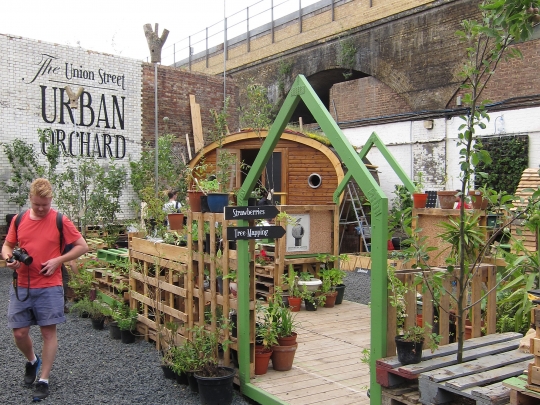
A temporary fruit orchard built in the heart of London as temporary nursery for plants and trees which will ultimately be gifted to local schools and community groups. Also home to Aalto University's Nest, sponsored by the Finnish Institute.
I started the week in London, where I was visiting the London Festival of Architecture to share some thoughts about design, complexity, and decision making informed by our work here at HDL.
Back in Helsinki we have things on the burner: working with XOXCO on a new part of this website, which will be helpful for sharing the work of the HDL Studios as well as supporting Studio-style work in the future; walking through HDL Global step by step with Emil+Stephanie to make sure that signage and printed material is designed for all of the needs, navigational, informational and otherwise; setting up contracts and schedule for some video work to kick off in early August; on the horn with Zurich to explore a potential new avenue for HDL.
We also put up a ton of images on Flickr. Over the next week we'll trickle some of those photos on the blog, but if you just can't wait to see you can find shots from all of our HDL Studios, most of which are by the talented Ivo Corda.
This update comes from somewhere over the middle west of the United States, as I type away thanks to inflight wifi. Marco, Justin, and I have been in San Francisco for the Design Management Institute's Re-Thinking the Future of Design conference. Largely focused on the effectiveness of an expanded use of design within commercial organizations, Marco was sharing our work on a panel with Kyung-Won Chung from the Mayor's office in Seoul, South Korea, as well as Bruce Nussbaum, Roger Martin, and Jeanne Liedtka that discussed design in a larger societal context.
The event had a pretty good Twitter feed going and there were lots of lively discussions. The crowd skewed towards a more experienced, and thus older, level of individuals but it was nice to see some young faces in the audience as well. My eyes are especially attuned to these kind of demographics when I visit events these days.
With the HDL Studios and now HDL Global we've made a conscious effort to make space for younger voices in the conversation. Not only is the youthful perspective important, but we want to create opportunities to expose them to a new way of working and a new set of tools while they have an entire career ahead of them.
Speaking of students, this week concludes the work of Anna-Leena and Christina who have been supporting the ageing studio. Rather than work part time for a month, they compressed their work into a focused week-long charrette, which might explain the "brain self portraits" they drew.
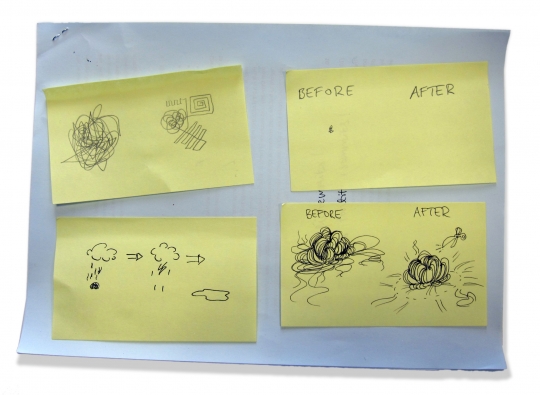
Not sure what this says about HDL, but it's a fun exercise to draw a brain self portrait. Give it a try!
While in San Francisco, Justin and Marco managed to sneak in a couple Low2No working sessions with Arup and I paid a visit to Adaptive Path, where I had a chat with Peter Merholz about his growing design consultancy, and global design practice in general.
It was a good week and now we begin our laser focus on getting ready for September.
Yesterday was a whirlwind tour of Jyväskylä, which we visited to see a cross section of how one city thinks about its elders.
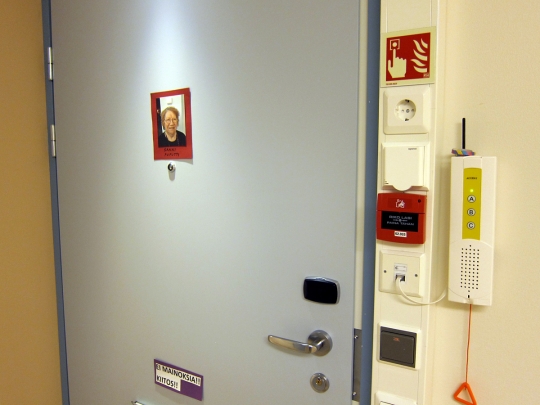
The balance between the human and infrastructural/institutional presence at an individual's front door inside an assisted living facility... interesting.
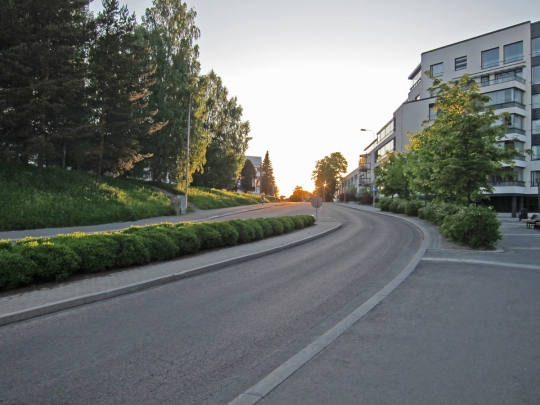
What it looks like at 11pm in the summer when you're at 62° north.
This post continues the story of Seungho’s trip to Cambodia with Aalto University. Read the first part if you want to catch up...
So here we were, nine of us from five different countries seeing Cambodia for the first time. Seeing and living were very different from reading, watching and listening in comfortable homes and lecture halls. Things taken for granted at home were not easily achievable here: clean water, sanitation, sewage management, waste management and education, just to name a few.
We were lucky to have people with many different backgrounds: industrial and strategic design, architecture, urban planning and landscape architecture, which enabled each of us to focus on a few topics to develop deep insight so that we could help others see problems from various perspectives while working in teams. Nightly briefings kept everyone clued in and these discussions were very fertile. We were also lucky to have students from different parts of the world in the course, as well as working with Cambodian students during our stay, which made the whole visit fluent and fruitful. Soon we’ll return to Helsinki and form groups with those who did not travel, expanding the diverse set of perspectives even more.
We are free to choose a site for our studio projects. Among the most terrible of the relocation sites was Trapieng Krasang, where the urban poor from four different places were involuntarily relocated to some 20kms outside the city and they now struggle to survive. This is a population of Tuk-Tuk drivers, Moto-Dub drivers, bakers, street fruit vendors, waiters and waitresses who have been relocated away from their jobs and now have no income. One lady, for example, makes two and a half dollars a day if she goes to the city to sell vegetables. However, it costs two dollars to get to the city! The relocated families were each given nothing but a 5 by 12 meter plot on a former rice field. The earth is fertile there, but the plot is far too small to be the source of living, let alone the money to build a shelter.
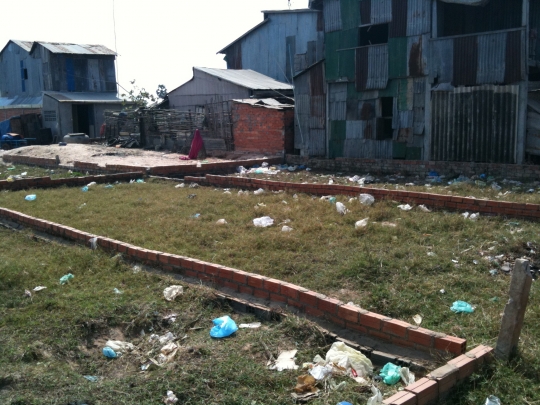
Empty plots in Trapieng Krasang. Many of the evicted families sold the plots for very cheap price and headed back to the city slums due to the lack of job opportunity. Sold plots have become the subject of speculation, which will make the rich richer.
This is compounded by the issue of unclear entitlements, which dates back to the Khmer Rouge regime when many citizens were herded out of the city. One third were killed and many of the survivors never returned. Eventually, those who did return to the city settled wherever they could – with whatever means they could. A few decades later, the Cambodian government, challenged with deep-rooted corruption, is selling the prime locations of Phnom Penh city to private investors who are taking advantage of murky land ownership status.
Development in the city of Phnom Penh is another significant problem. Two years back, a private investor bought the Boeung Kak Lake area which is about 1 square kilometer and began filling in the lake to build a hotel and resort. People near the lake have been forcibly relocated and a large fire during our stay in Phnom Penh cost hundreds of families their homes in a single night. Now Boeung Kak Lake is as small as one third and soon will be 10 per cent of its original size. As summer brings monsoon season we will see the impact of the such radical environmental changes. Recently the Royal University of Fine Art as well as the National Museum have been sold to a private investor and the students are under threat of eviction.
![Boeung Kak lake as of March 2010.
Photo credit: Save Boeung Kak Campaign [http://saveboeungkak.wordpress.com]](../../peoplepods/files/images/383.540.jpg)
Boeung Kak lake as of March 2010.
Photo credit: Save Boeung Kak Campaign [http://saveboeungkak.wordpress.com]
Some can say that development in Phnom Penh is giving jobs to construction workers, hopefully boosting the economy, and making the city a better place to live in the end. However, the number of the people evicted from the city is much higher than the number of workers hired. Does development have to be at the expense of so many homes, jobs, and lives lost?
The economy of urban poor in Phnom Penh is shallow and fragile: many of their livelihoods are very much dependent on tourism, a competitive industry with significant competition from nearby Bangkok. Cambodia imports many things, including foodstuffs, from Thailand and Vietnam, thus making commodities expensive. The shift from agrarian to industrial society, then an industrial, and on to a service and knowledge-based economy appears to be a long journey for Cambodia.
City in Crisis course does not pretend that problems of this nature can be mitigated immediately. Rather, it aims to have us students aware of and ready for the real problems of architecture and design for a longer term.
Back in Helsinki, we’re focusing on five different projects: a master plan including urban farming solutions for the relocation sites, in particular Trapieng Krasang as a case study; a “sub-center” concept for relocation sites, which brings markets and basic facilities to the area; the rehabilitation of remaining lake areas south of Phnom Penh, with specific attention to management of sewage flow; disaster management for slum inhabitants; and finally mine, a strategic road map and a framework for the economical development of the urban poor of Cambodia.
My question started from the living condition of Trapieng Krasang but my interest has soon extended to the economy of urban poor and the mindset: what does a pathway to economic stability look like for the relocated families of Trapieng Krasang?
I’m Seungho Lee, a Masters student at Aalto University School of Art and Design, studying in Industrial and Strategic Design and currently working with Helsinki Design Lab as an intern. My studies have taken me to Cambodia, where Aalto University's City in Crisis course is expanding the design discourse to include history, corruption, land entitlement, education, political enfranchisement, economics and more. This post was written a while ago, and it's part one of three covering my studies in the City in Crisis course.
As I type this, I’m 8000km away from home, waiting for a return flight from Phnom Penh, Cambodia back to Helsinki. I’ve been here for two weeks with nine of my fellow students as part of the City in Crisis course. Although I came to the airport three and a half hours early, I don’t mind because I wanted to escape from the city: there’s been a lot to digest after two quick weeks of fieldwork.
During that time we’ve been visiting Angkor Wat, the floating village near Siem Reap, Silk Island, a few slum areas and few eviction sites in Phnom Penh as well as relocation sites where those evicted now struggle to survive. We've also met and learned from representatives from various NGOs: STT, OPC, UN Habitat to name a few. Corruption, lack of secure tenure, almost no industry, false development, lack of education, slavery… this is the reality for many of Cambodia’s urban poor.
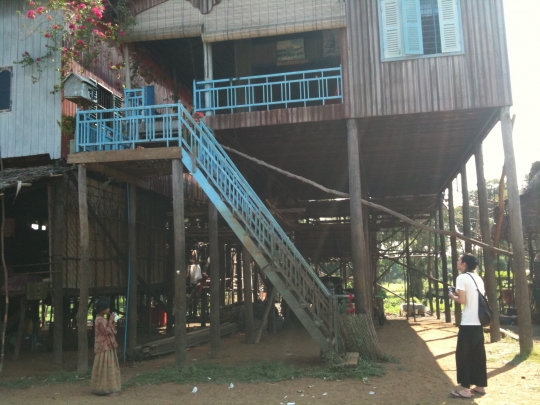
Floating village, a vernacular principle in Cambodia where the rainy season continues for six months.
Architects in the wealthy parts of the world have a tendency of being primarily interested in what their more successful counterparts in other wealthy parts of the world are busy with. The professional magazines in Europe, North America and the rich parts of Asia are concentrating on the “wow-factor” and its various manifestations. It is far less common that these publications deal with the everyday problems of the majority of the world’s problem.
– Hennu Kjisik, Veikko Vasko, & Hunphrey Kalanje. The Final Report of City in Crisis, May 2009
This phenomena is evident in recently published Phaidon Atlas of Contemporary Architecture that introduces 16 Finnish projects among 588 European projects, but only 26 projects from whole Africa and 184 projects from Asia. As pointed out by Hunphrey Kalanje, one of teachers of the course, architecture is in many cases political: it works with capital, for capital, and by capital.
The City in Crisis course has been offered since 1993 by the department of architecture in Aalto University School of Science and Technology with an aim of strengthening the global awareness and social conscience of its students, as well as increasing our understanding of the realities of life and conditions of professional work in developing countries.
Since these things are notoriously difficult to be taught in lecture halls and studios, the annual fieldwork period has become an essential part of the teaching and learning process since the beginning. After a total of ten years in Africa - Rusfisque, Benin and Grand Popo in particular - City in Crisis has turned its eyes to the east, and the first group of students traveled to Cambodia at the end of February 2008.

Some of my fellow students in the heart of Angkor Wat. One can easily imagine how glorious the Khmer civilization once had been.
The course is designed in two parts: the first of which aims to acquaint its students with various development issues all over the world and local vernacular principles. During the autumn semester in 2009, we read about and studied about four themes: development discourse, global issues, urban agendas, and construction in developing economies, which was followed by research into the vernacular principles of indigenous architecture in different climates.
The second part consists of lectures and seminars dedicated to issues in Cambodia, the fieldwork to Phnom Penh and Siem Reap and eventually the studio work back in Helsinki. From January of this year invited lecturers have talked about issues in relation with water, development, corruption, environmental issues, capital, and speculation in Phnom Penh.
After studying these issues from a range of scales, both from the global to the local in Cambodia, and from the past to the present we packed our bags for two weeks in Cambodia. It was time to see and to “live” the reality.
Check in tomorrow for more about our time in Cambodia.
Ambiguous Middle Phase continues but now with some glimmering of what lays ahead, beyond this chaotic period for HDL.
The week was bookended by a laundry list of activities related to the three Studios we're planning for summer: visiting a possible space right next to Delicato; interviewing students to join the team in supporting research roles; confirming studio members; interviewing two top talents experts on ageing; hunting down a map of internal migrations; and checking in with Gaia, who are preparing some futures projections. That's the sort of stuff that is continually churning, but I'm making note of it here so that we can look back in a couple months and remind ourselves of the rich crucible of everyday chores that created a background for deeper considerations about HDL.
On Tuesday Marco, Minna, and I took a day trip to Copenhagen to meet the fine people at MindLab and INDEX. Established as a design facility by three ministries (Employment, Taxation, Economic & Business Affairs), MindLab is one of the very few examples that we know of where design capability is explicitly integrated into government activities. They're been working to help government bodies improve the services they offer to the citizens of Denmark with a mix of design, social science, and public policy expertise.
After a very good and very hurried lunch we met with Kigge and Liza at INDEX:, the world's largest design award. It's set up as something along the lines of a Pritzker or Nobel for socially-beneficial "design to improve life." Naturally this high ambition for the contribution of design is something that we very much share. As is the recognition that to foster the ability of designers around the world to make a larger impact means very literally supporting them, enabling them to work without immediate clients. Or even markets. In particular it was nice to hear a bit about where their thinking is headed in the future. We're sworn to secrecy though, so stay tuned!
It's great to find allies – more and more of them every day. Not so long ago, if you said that you're interested in design with a social motivation and a practical imperative, you would have found very few people to share those aspirations with. Both of these discussions in Copenhagen underscored the fact that not only is this broader definition of design becoming a simple fact of the word's definition, but that there are more and more groups developing keen insights into implementation. What are the barriers to delivering improvements? How do we rethink the structure of design practice to open new opportunities? Who can designers involve in their work to benefit from expanded expertise on making things happen?
This is exciting to us because the design community is finally beginning to answer 50 year old questions. We're making those visionary "what ifs" from the 1960s into "why nots" – and "why not" is a much more operable question.
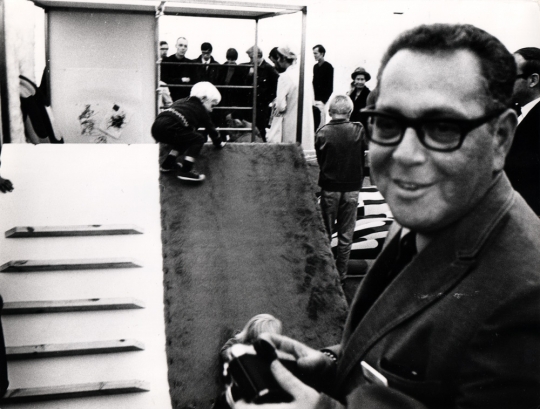
Victor Papanek in front of a prototype learning environment for children at HDL 1968. Photo by Kristian Runeberg.
With my laptop battery dying, I'll close with a quotation from HDL 1968 by Victor Papanek, the father of green design. It's unusual to see him praise the consumer products industry, but here his message is more about bootstrapping than cars. Replace "industrial designer" with "strategic designer" and this quote pretty much sums up the transition we're experiencing right now, as design is increasingly integrated as a core competency in governmental-scale problem solving.
If we go back to the history of the design profession we find that it started in the late twenties... around 1927, 1928, 1929 is when industrial design began in the United States.
It started by someone saying "I am an industrial designer." And then going around to radio companies, to electric companies, to truck people and so forth saying "I am an industrial designer, and I can do this and this and this and this."
And the companies were sometimes impressed and hired this man, be he Raymond Loewy or anybody else, and the same people are still working for the same companies.
Suomenlinna, Helsinki. July 17, 1968.
We agree with Victor: it takes a daring few to open new areas of opportunity!
Hello from Singapore! The big news is that Helsinki has officially won World Design Capital status for 2012 with its Open Helsinki proposal. We've been chatting with Pekka Timonen off and on as he lead the bid team and it's a real pleasure to congratulate him and everyone on their fantastic work. So while we still have our eyes set on 2010, start marking 2012 on your calendar too.
In honor of the win, the last day of ICSID World Design Congress saw a bit of a Finnish invasion with The mayors of Helsinki and Espoo as well as representatives from the Foreign Ministry, Helsinki Design Week, the Design Forum, Taik, and Marco and I representing Sitra and HDL. Yrjö Sotamaa was so excited he ran around the congress hall with the World Design Capital flag trailing him like a cape.
The format of the congress was interesting for us to see since it has some resonance with how we're preparing HDL 2010. A series of "studios" were organized in the year prior to this week, each with the task of envisioning life in 2050 as it relates to a number of focus areas ranging from agriculture to entertainment. The studio heads took widely different approaches to their work. Some seemed to really get into the format and developed research seminars around their efforts, others seemed to have simply added a few new slides to their default presentation decks. Some presented plausible scenarios rigorously argued and supported with well-cited evidence, others relied more on the whims of the presenter to sketch out a possible future. The degree to which foresight work delivered by foresight experts dominated the two days of conversation that I attended highlighted the extent to which design practice has been focused on current day and immediate-future realities. Designers generally aren't in the habit of proposing floating-car futures any more, are they? Is this good, bad, or gray?
The congress reminded me of Jim Dator's Four Generic Images of the Future, a useful framework that Stuart Candy introduced to me at the University of Hawaii back in March. Stuart underlined a simple fact: if we're not in the habit of imagining the future we have a much harder time manifesting a desirable one. The work that Stuart and his colleagues are doing is essential and seems like ripe territory for collaboration with designers. Thinking about the future gets at ethics in a novel way: if you can imagine anything, why are you imagining this specific thing?
The ethics of design practice was a recurring theme both here in Singapore and last weekend in Torquay. If designers become more involved in projects with a broader social impact – and particularly if they begin to find themselves at the table of political decision makers – the stakes of our work become very high. Personally, I believe that conscientious, talented people generally rise to the challenges they are given and there's nothing better to prove your mettle than to have it tested. Still, I'd like to see the conversation about ethics of design move to a more nuanced level.
The work of groups like Architecture For Humanity is fantastic, but doing pro-bono projects for under-served populations is not the only option for ethical practice. A binary argument between good and evil design practices may do more harm than good by allowing lines to be drawn and sides to be taken that are almost religious in their fervor. In that sense, what I'm lamenting is the lack of ethical debate about how and why we conduct our work rather than ethical judgment.
The conversation took an unexpected turn in Singapore when Chris Bangle and a few others speakers argued that the congress was filled with too much doom and gloom. "You can't push someone to make significant changes in their life," Chris argued, "you have to pull them." In other words, we need to find ways to seduce the planet to live sustainably rather than guilting them into it. Probably need a bit of both, don't you think?

A view over Singapore's developing waterfront snapped in between conference sessions.
Together with the Idea Factory we hosted an HDL dinner with some fantastically interesting people for all over Singapore. Ban Y J – the bon vivant, designer, and entrepreneur behind Stikfas – emphatically spoke about the need help designers break through the "surface tension" between being a garage start up and a viable market entity. In his words, marketing is the key to "raising a hand up and being seen." Particularly in countries with small home markets like Finland and Singapore, breaking through that barrier is critical for long term success. But perhaps even social issues need the right marketing campaign to give them the appropriate chance to survive in this crowded world. Responding to Joanne Yap's introduction of Jurong General Hospital's move from "an illness focus to a wellness focus," Ban asked how you entice people towards wellness? One key strategy is persistent and open community engagement, something Jurong has already started: how many hospitals exist on Facebook before they are entities in the real world?
In the interest of being consistent, I'm checking in with another weeknote even though it's late and I'm tired. Very tired.
This week began in Santiago with Justin and I visiting the Ministry of Housing as well as some other key partners for Elemental. I'm getting more used to having these sorts of conversations inside the halls of government, but for the moment it's still a learning process. We're calibrating the conversation to the audience and getting better at articulating the specific contributions that design has to offer. It feels like an important thing to be figuring out.
Thanks to the international dateline we didn't have a Tuesday. For that matter, thanks to jetlag between Santiago and Sydney, Wednesday was pretty much a waste as well, with the notable exception of a great dinner with Dan Hill of Arup Sydney. We covered everything from urban informatics to fruit bats.
We spent two days with Second Road, digging into their archives and meeting some of their past collaborators and clients, to understand more about the work that they've done with the Australian Taxation Office. It was truly impressive to see the extent to which the ethos of design has seeped into that organization. How many tax offices in the world recruit designers every year? Now we know of at least one!
Among other activities in Helsinki, Adriel spent most of Thursday in an old-folks home learning about what it takes to care for the elderly. Meanwhile Ezra was making visits to Helsinki Police, the Finnish Military, and the Ministry of Education... I know, right?
Over the weekend Justin and I had the pleasure of participating in the Swinburne University Design Thinking conference in Torquay, Australia hosted by the dean of the design faculty, Ken Friedman. It was encouraging to hear the diversity of the conversation and in particular to discover that we're not the only ones who are a bit uncomfortable with the term "design thinking." What about doing? What is design without making? As we increase our appreciation for design as a way of understanding problems let's not forget that design is always obliged to act. This is precisely what we are concerned with at Helsinki Design Lab: how do we best think and do, conceive and act.
One week and eight thousand kilometers later, Justin and I are in Santiago de Chile where we've been the guests of Elemental as we learn about this incredibly unique and exciting project. Elemental is a "do tank" that started as a relatively modest project with the goal of providing new housing to upgrade a portion of the slums in Iquique, Chile. Fast forward to today and Elemental is actively working on projects in multiple countries and expanding from a laser focus on housing to the larger challenge of using "the city as a shortcut to equality."

Santiago de Chile as seen from the offices of Elemental.
When we talk about strategic design, there are few people who fit the description better than the team at Elemental. By leaning on expertise from areas such as law, traffic engineering, community organization, economics, and sociology the designers at Elemental are working to develop systemic change within the interlinked problem space of the city. Building new homes for slum dwellers is one thing, but explicitly designing those houses as a tool to bootstrap the owners out of poverty demonstrates an important reframing of the problem, required dedicated follow through, and has delivered much more meaningful and valuable results.
After visiting two of Elemental's projects and speaking with many of the team members my brain is a little saturated. I've been culling through notes and trying to make room for our meetings with the Minister of Housing and the former CEO of Copec, both early sponsors for the Elemental work. Tomorrow is a full day and then we're off to Australia. And yes, this month is heavy on the travel. That's why we support the Carbon Fund.
One thing we heard this week in Chile that echoes previous conversations in many different places: people want to hire design services, they believe in design services, but their procurement systems don't allow it. How do you buy something when your procurement system has no check box for it? How do you invest in a process when you're used to buying products? This is going to be a recurring theme.
By now Adriel and Ezra should be landing in Finland where they each have a busy week of fieldwork for the studio briefs. Our session last Monday was intense but great. One of those moments where a lot of swirling thoughts become more clear – still cloudy, but we're developing a nephology to describe them. The Breslin was kind enough to lend us their mezzanine for a half day meeting. Those people make a mean breakfast.
Speaking of hotels, Minna has been securing hotel rooms for us in Helsinki. Checking these bits of logistics off the list is ever so satisfying.
Slowly we're exploring the viability of the HDLT, a project which we'll share more about when there's something solid to share. Marco has begun due diligence on this in anticipation of first discussions with some key partners next month. He's also lining up some key people for HDL 2010, including our first confirmed studio designer. We're waiting to hear back from another key invite – a speaker for HDL 2010 that would make me pleased as punch to have on board.
As I write this, the lobby here at the ACE hotel in New York is a raucous hive and I'm happy to be tucked into a small but comfortable room upstairs. Justin and I have come to NYC as the second stop on a three week trip that will cover six cities on five continents. This trip is largely about meeting strategic designers around the world and to see their work in context. It's about finding champion projects that make the endeavor of strategic design tangible and accessible to a broader audience.
On Wednesday we met up in London to visit the Helen Hamlyn Centre where Maja and Rama gave us an in-depth introduction to the work they have been doing with DePuy. It was a great way to start the research and it's going to be interesting as we gain a more complete understanding of the project by meeting their clients and other groups who were touched by the design work. One thing is definitely clear: the importance of having a client who advocates for design is immeasurably large.
We also had the chance to drop by live|work and hear about some of their projects, particularly Make It Work done for the Sunderland City Council. With a large population of long term unemployed people in Sunderland live|work were asked to help develop a system that would bring inactivity rates down. By coordinating among the 280+ organizations that already offer services to unemployed and in-need populations, their solution helps match the right kind of support to the needs of the right individual which increases results and decreases costs due to wasted or ineffectual services. This video gives a nice introduction but there's certainly a lot more to dig in to.
Marco made a day trip to London for an interview with a great magazine which we are very excited about, so we took the opportunity to spend a solid five hours taking stock of the past month and planning for the next few ahead of us. These day-long meetings seem to work better the further they are from the office, but I suspect that mostly has to do with the fact that your calendar is marked out-of-office and thus a clutter of meeting invites is avoided. We've been having stock-taking meetings every couple months and it's working well for us as significant markers between which weekly and daily coordination fits in. Set the strategy, adjust regularly.
Despite the fact that it was absolutely gorgeous in New York today Adriel, Ezra, Justin, and I spent the day locked in a conference room hashing out developments in the content of the studio briefs. There are lots of ideas flowing and we're starting to narrow in on some critical dimensions that will bracket each one of the studios. The difficulty in this sort of situation is to strike the right balance between providing a stable enough frame that the studio participants have something to react to, while maintaining enough flexibility that the framework will be durable. We're getting there.
This week: more, more, more. Meetings with friends old and new; a full day of conversation with the Jonathan Rose Companies about their holistic approach to development; a kickoff meeting with the talented people of XOXCO, who are going to be developing the new HDL website; and then heading to the airport and on to South America.
There are few places that could serve as a better platform for a discussion about architecture and the city than the roof of a skyscraper, smack in the center of Los Angeles. Last week Postopolis! LA convened a group of more than 40+ speakers for five days of near-constant conversation. I was pleased to be able to participate by sharing the story of Helsinki Design Lab 1968, a bit about where we're going with HDL 2010, and to introduce the Low2No competition that Sitra recently launched.

Photo from Storefront for Art & Architecture on Flickr.
It was great to see some old friends and meet many new ones, but I particularly want to highlight the way that Postopolis! LA came to be. On this blog we've been describing different kinds of innovation, and Postopolis! is no exception. Unlike most events which have a central organizer, Postopolis! was hosted by six bloggers from five different cities, all enabled and made fluid through online collaboration tools. Think about that for a minute. The images and ideas from Eric Rodenbeck's presentation about data visualization, Benjamin Ball's design by process, and Ben Cerveny's thought-wander through the territory of the city as operating system will be playing on repeat in my head for a long while, but the quiet triumph of Postopolis! LA was its own formatting – the very nature of the event as a unique collaboration might just be the most impressive part of all. (This may mean we have too much event-planning on the brain...)
Now that we're all back to Helsinki to rest up and let these experiences soak in, this blog will probably be a bit slow for a while. In the mean time, you can browse the Twitter stream from Postopolis for extensive notes, excerpts, and the occasional dérive.
Is political protest a relic of the 20th century? In a way, this is the question that The Hope Institute asks here in Seoul. As a non-profit that runs a number of different advocacy and education programs, the Hope Institute proposes that "social invention" can replace protest as an effective tool for improving the quality of daily life. Over the past two years they've collected more than 16,000 ideas and are actively prototyping some of them.
In some of their most interesting work the Hope Institute uses crowdsourcing to collect ideas that can improve various aspects of living in Korea, from tweaks to the Metro system to alternate farming practices. After collecting advice from the people on the ground, Hope Institute brings together various stakeholders (be they government, business, or other communities) to join in one conversation about the problem at hand and then prototypes solutions and publishes their findings.

Photo from Arne Hendriks on Flickr.
One ambitious project they're working on is to change the visual experience of Korea's busy streets. With little regulation applying to the way that signs and advertisements are applied to building facades, the streets can quickly become a cacophony of sales pitches. Hope Institute's "Sign is Design" program hosts the municipal offices in charge of signage, the sign owners, and the sign designers in a single conversation so that all parties can work together to find a more orderly and pleasing way to deal with signage. Recently they adopted one of the rundown streets in Busan's old city center and applied their process to redo the all of the signs. If this were all for the sake of a more beautiful street we could note its improvement briefly, but post-renovation shop owners have noted that foot traffic and sales are both up. This increase in business is the direct outcome of good design being applied to a problem at all levels, from the strategy of bringing together all the stakeholders down to the graphic design of the individual signs.
If you speak Korean you may enjoy watching this presentation by Hong Ilpyo from LIFT ASIA '08, Research Fellow at the Hope Institute, where he talks about more of Hope Institute's work. The Q&A is in English and starts about 15 minutes in.
From the top of the ArcoTower in Anyang, a town in the southern reaches of the Seoul metropolitan area, it was quite clear what happens when a functionalist approach is taken to urban design: you get a city comprised of rubber stamp blocks, each the result of some generic equation optimized for things like "habitation units" and traffic flows. Top down planning can be quite efficient and was an important tool in South Korea's rapid urbanization in the latter half of the 20th century, but while growth rates may change quickly, concrete stays put much longer. In other words, buildings and cities planned with only the near future in mind may be immediate successes, but can quickly morph into liabilities when looked at over the span of multiple generations.
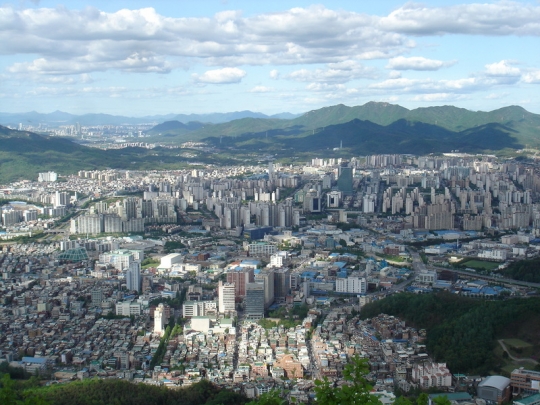
Photo: Anyang, South Korea photographed by Yong27 on Flickr.
Mr. Ohn Yeong-Te, President of the Architectue & Urban Research Institute (AURI), crystalized the problem that architects face when trying to improve the quality of the built environment by stating that designers are responsible to three parties: the people who live their daily lives in and around buildings, the businesses which rely on the smooth function of the city and its structures to ply their trade, and broader society which deserves high quality architecture that may become "tomorrow's cultural heritage." These different levels of responsibility relate to various strata of decision making from the grass roots all the way up to national policy. Without a perspective that incorporates design input at all levels of decision making it's very difficult to deliver high quality buildings.
This eloquent description of a need for planning that is integrated and informed from top to bottom was further expanded upon by Cho Sang-Kyu, Manager of AURI's Architecture and Urban Information Center, who described the need for architects to collaborate horizontally across disciplines. As society puts increasing demands on our buildings (it must be green! it should sustain itself financially!) the architect finds that they must work directly with other disciplines to deliver the informed perspective that is required of them.
Although AURI's work is at the national level (they report to the Parliament of South Korea), Anyang was the perfect place for this discussion about the potential of design-informed decision to result in high quality spaces. With iniatives like the Anyang Public Art Project, the city itself is actively looking for solutions to the rubber-stamp urbanism they've inheretied from the mass-production past.
Later in the day, a visit to the buzzing offices of Cho Minsuk, Principal of Mass Studies, provided some context to the discussion at AURI. Where are the precedents for this kind of integrated thinking amongst the community of designers? I'll sign off now with this as an open question to you: Which architects and designers are finding clever ways to insert themselves into these larger questions? Who do you look to for role models in this area?
On our last day of meetings in Bangalore, we had the pleasure to visit Srishti School of Art, Design, and Technology where Geetha Narayanan shared with us a bit of the history of her ground-breaking school and some of the opportunities and challenges facing educators working in India today. Geetha and her team have built a wonderful momentum within their school which has grown from an inaugural class of one single student in 1996 to an enrollment of over 250 today.
A theme that comes up again and again as we visit educators in different countries is the need for designers to be better trained to operate outside the bubble of art and design. It was great to hear Geetha flesh out the term "design education" beyond the training of designers to include something akin to the concept of the embedded designer I described previously. With the collaborative, studio-style approach gaining popularity in all levels of education from primary up through grad school, it's exciting to note that these students are learning new ways to think about and see the world in addition to the content of their various subjects.
To imagine that a pedagogy which uses design to helps students better understand the world could be taking root in one of the planet's most populous countries is an exciting proposition indeed. Being here for a few days has given us time to get only the smallest peek into life in India, but it was enough time to clarify how great the opportunities are for even the smallest of innovations in a place as vast, populous, and talent-filled as this.
I’m on my way to a meeting, so forgive me for the haste with which I jot down the start of an idea (I’ll expand later, but this is too important to start later).
We had an inspirational morning in Bangalore today. One of them was with Poonam Bir Kasturi and her team at the Daily Dump project. This is an amazing project driven by a critical issue: Sustainability. While the term is growing with “cult-like” popularity, most of the airtime being given is from a 30,000 feet perspective. Poonam’s team is deeply rooted in the complexity of the problem as it confronts daily life. The focus is on waste, tackling it from a composting perspective through a systematic design approach that is rooted in meaning, culture and economic realities. This is not a “deep dive” into the problem, but rather a powerful example of how design is being applied to create real social innovation by re-designing its value chain (sorry, I hate this business term, but you get what I mean).
Over a wonderful lunch, we discussed many issues primarily focusing on design innovation, the team’s “subversive” way of redefining problem boundaries, and culture…. seems like our discussions, almost without exception, end with the question of culture.
I have many thoughts racing through my mind as I realize my growing skepticism for what I would call “board room innovation”. Back on this topic and Poonam’s work shortly…


